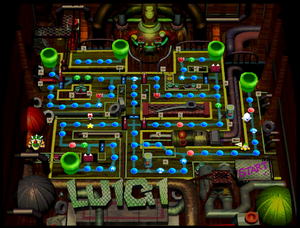Luigi's Engine Room
| Luigi's Engine Room | |||
|---|---|---|---|

| |||
| Appears in | Mario Party | ||
| Difficulty | ★★★ | ||
| Availability | Default | ||
| Description | "Start up the mysterious engine room with your Star Power." | ||
| |||
- “This board is set in the mysterious Engine Room. Steel doors block many of the junctions, and players may only take the paths that are open. The doors move at the end of each round, changing the paths that can be taken.”
- —Mario Party instruction booklet[1]
- “This is the Engine Room. The Engine in the center hasn't enough energy, and it won't move at all. We must search for energy and get that engine moving. I wonder what will happen when it starts moving again? But beware of that fake inventor, Bowser! Causing trouble for people is what he lives for.”
- —Koopa Troopa, Mario Party
Luigi's Engine Room is Luigi's board in Mario Party. Players need to collect Stars to power up the engine in the middle of the room (but actually in the rear of the playing board). The main feature is the board-wide system of red and blue doors. One set rises up to block specific paths, while the other set goes down to open other paths. The doors switch at the start of every turn, when players land on certain Happening Spaces, or if a robot on the board called Pisudon is paid 20 Coins to switch them. Happening Spaces on steam generators near the engine make steam rise up out of the respective generator, propelling players to a higher section. Players that are sent to Bowser see his "Make As Many Coins As You Want Mecha" in action. At the cost of 20 Coins, players receive a free Coin, or if they have less than 20, he takes them all without using the machine. No matter where the players go, all paths end in Warp Pipes that lead to Boo, who is near the start. Any time the players buy a Star, the space that Toad was on becomes a Chance Space.
At the end of the game, the winner's Stars form into a large star that goes over to the engine and powers it up. It is revealed that the engine and surrounding board are located inside a ship that resembles the Rainbow Cruiser (as seen in Rainbow Ride in Super Mario 64 and later Rainbow Cruise in Super Smash Bros. Melee, Super Smash Bros. Brawl, and Super Smash Bros. Ultimate), with the winner standing at the front of the ship. The players in second and third place, as well as Toad, Koopa Troopa, Boo, and the Star, accompany them, while the player in fourth place stays in the engine room and is burned by the steam generators while Bowser laughs at their misfortune.
Spaces[edit]
The following table shows how many spaces there are on the board and how many there are of a certain type.
| Type of Space | Number of Spaces |
|---|---|
Blue Spaces |
58 |
Red Spaces |
4 |
Happening Spaces |
5 |
! Spaces |
0 |
Mini-Game Spaces |
4 |
Mushroom Spaces |
3 |
Bowser Spaces |
3 |
| Total of Spaces | 77 |
There are no ! Spaces initially on the board, though every time a Star is bought from Toad, an ! Space replaces the space he was on.
Gallery[edit]
The map's cast artwork
Quotes[edit]
"This is the Engine Room, but what kind of Engine Room is it? I have absolutely no idea!"
"In the center of the Engine Room, there is a great, big engine. But now, it isn't moving at all."
"It sure is big, that engine. I wonder what would happen if we got it going again?"
"Surely, the engine isn't moving because there isn't enough energy. If only there were energy, it would move."
"But what kind of energy would it take to get it moving again? Do you know?"
"Energy great enough to move an engine. Probably, none other than Star Power!"
Names in other languages[edit]
| Language | Name | Meaning | Notes |
|---|---|---|---|
| Japanese | ルイージのエンジンルーム[?] Ruīji no enjinrūmu |
Luigi's Engine Room | |
| French | La salle des machines de Luigi[?] | Luigi's Engine Room | |
| La Machinerie de Luigi[2] | Luigi's Machinery | ||
| German | Luigis Maschinenraum[?] | Luigi's Engine Room | |
| Italian | La Sala Macchine di Luigi[3] | Luigi's Engine Room |
Notes[edit]
- This is the only board in the original Mario Party with context-sensitive Happening Spaces.
References[edit]
- ^ Mario Party instruction booklet. Page 19.
- ^ Official Nintendo French magazine N13. Page 25.
- ^ 1999. Mario Party instruction booklet (JPG). Nintendo of Europe (Italian). Page 133.









